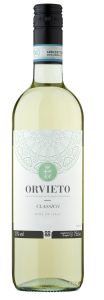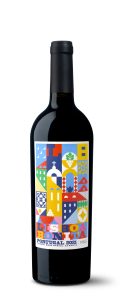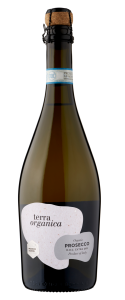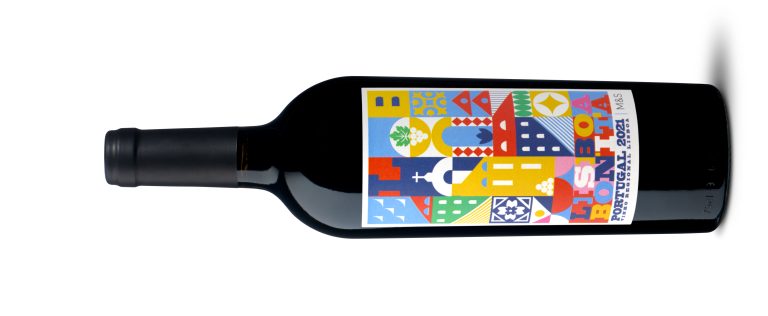Last Monday’s Top Tips (featuring Vinho Verde and Australian cabernet franc) was a blend of the (revived) traditional and a recent trend.
Today’s selections tread a broadly similar path.
First comes an Italian favourite from way back that dropped off the radar as newly revived varieties (e.g. fiano) gained attention.
While two swallows do not make a summer, this example does suggest that Orvieto could well be back on form.
Meanwhile for a red, I have headed to a major current source of great value wines – Portugal.
Many MidWeekers head automatically for those bottles displaying the big yellow tram, and this is similar in style and from the same region.
In what is surely no accident, this also has a colourful label with prominent shades of yellow.
Both bottles are well worth seeking out.
As is normal here, pictures and hyperlinks are provided where possible to guide you straight to the right wine on shelf or web page.
First, then, that Italian white
2023 Orvieto Classico (£6.85 at the Co-op and 12% abv):

Time was when a stand-by “trattoria” wine was this white from Italy’s Umbria region.
Possibly because its blends seemed have less of the rich and nutty grechetto grape than before, Orvieto’s popularity has faded.
However, with medium-bodied, floral peach and cooked apple flavours, this example suggests it is right back on form.
Reinforcing that conclusion, comes firm pink grapefruit acidity underpinning a clean mouthfeel, and gentle, vaguely saline, viscosity.
NB:- The price instore (shown here) is likely to differ from the one shown on the Co-op website.
Switching to a red
2022 Lisboa Bonita (£8 in M&S physical stores – and, at the same price in Ocado, and 13.5%):

Based on the excellent recent examples from the region, many of us are on alert for the red wines of Lisboa.
Here, the Portuguese producers there have created a real treat – with a blend of no few than six grape varieties and partial oak aging.
Intense and almost black in colour, the resulting wine is centred around nutty cherry, damson and blaeberry flavours.
That backbone is neatly supported by fresh acidity, firm tannin and suggestions of chocolate and cinnamon.
Top Tip Bonus.
Terra Organica Prosecco (£12 at Ocado but 25% off when you buy a mix of six this month and 10.5% abv – also at Sainsbury’s):

Three reasons to try to catch up with this prosecco, especially while it is on offer:
- It was an award winner at the Drinks Business Global Prosecco Masters.
- It has a gentle abv – at a mere 10.5% – but doesn’t show it.
- It is a great example of how tasty organic wines can be.
Watch the small, energetic and busy bubbles on display here and note how they lead nicely into the wine’s apple, grapefruit and pear flavours.
Supplementary qualities include vibrant sherbet lime acidity and a contrasting savoury depth.
One or two comments on the retailer’s website suggest some found this a little sweet but that was not my experience.
Rather, its acidity and savouriness actually making it seem drier than many proseccos.
And a footnote
Perhaps you are looking for something to make up the half dozen this promotion requires.
If so, try the similarly priced sister wine – Terra Organica Primitivo that is also included in the “25% off” deals.
The wine itself is excellent with vivid smooth blackcurrant flavours and a delicate savoury edge.
After today’s focus on Portugal and Italy, I broaden the picture on Thursday to cover the entire wine world – but from just one retailer and with choices made by “asking the audience”









20 responses
Hi Brian,
Noted your usual caveat about co-op pricing!
In advance of the (usually excellent) co-op online tasting, on Thursday evening, bought one of the 3 featured Argentine wines – Co-op Irresistible Fairtrade Tilimuqui Sparkling. It was £8 in my local Felixstowe store – which is “East of England Co-op group”. Looking at the national website, the wine is listed at £9, but “member’s price” is £5.85, until September 24th.
Member in this context is for those who (like myself) have lashed out £1 for lifetime membership of the National Co-op group, and have received a loyalty card that can be scanned to get such member’s prices. This card is not recognised in the Felixstowe store, but my, separate, loyalty card for The East of England co-op group, is recognised and gives you “points” but not the national discounted price. I followed this up a while ago, and the East of England position is that they may adopt, at their discretion, some national co-op pricing offers.
Also worth noting is that no East of England co-op stores enter their wine availability data into the (potentially) excellent “co-op find a wine stockist” facility. Confused me for a while as every wine I tried to locate seemed to be available in many Essex stores, but never in Suffolk!
Anyway, I opened the bottle of fizz yesterday at a family birthday gathering, and it was a very pleasant wine, zesty with hints of white peach and pear. Great value wine for informal events. It was very popular, several noting that they had never had an Argentinian fizz before. The web site doesn’t mention, but it is 2024 vintage and Torrontés grapes.
The other wines featured in the co-op tastings are: Co-op Irresistible Fairtrade Malbec and Co-op Fairtrade Pinot Grigio. Malbec is not one of my goto grapes, but this one has a good Decanter review, and is also on a member’s price offer, £6.75, down from £9.
Worth noting that the National Co-op card can be uploaded into your iPhone wallet, so don’t need to physically carry yet another loyalty card. The East of England card cannot be uploaded.
Yes, we have previously discussed the effects for the customer of the Co-op’s regional structure (and the possibility that the website is not always up to date). Short of not featuring Co-op wine – which would be a backward step because so many are so good – there is little I can do except add a warning caveat.
Hi Richard
We bought some of that Fairtrade Tilimuqui Sparkling wine (recommended price £9), got ours for £6.50 (members price) for a 75cl bottle, I think the £5.85 refers to a 70cl bottle, so it says online (all very confusing) even the staff weren’t sure. Anyway, it was a pleasant enough fizz, made with the same method as Prosecco, for me though nicer than a lot of Prosecco’s I’ve tasted, I will get some more at that price.
Thanks again Brian for these priceless tips. Totally agree about Orvieto – one of those wines that’s so often overlooked and underrated (a bit like Aligoté was back in the 80s/90s – in my early Paris days it was associated mainly with kir).
So, Orvieto definitely worth searching out across a number of sources.
Glad we are on the same page about this Gerry. A bit sad though that Aligote remains to this day so seriously underestimated.
Hello Brian,
Agree with your comments about Aligoté. However it may well have it’s day in the sun- literally.
Climate change is making life difficult for Chardonnay in Burgundy.It can lose it’s acidity easily and become less vibrant and over ripe.
Aligoté ripens more slowly and retains it’s acidity and freshness.
The Wine Society have an outstanding Generation Series Bourgogne Aligoté 2022.
Organic and produced by top winemaker Sylvain Pataille .£18 is a lot to pay for a bottle of wine,but this could easily sell for double.
I can also endorse Sylvain Pataille’s Aligoté wines, although, frankly, they are pretty “green” when young.
I understand another factor in this grape’s revival is that land in Burgundy was so expensive it was difficult for talented newcomers to gain any sort of foothold. However vineyards with existing and unfashionable Aligoté plantings, were substantially cheaper. So the new guys came in, bought the plots, and surprised many at what could be achieved with Aligoté!
I guess a similar story has happened in many areas where poorly managed, or volume driven, indigenous varieties lost favour to the fashionable, but not always suitable, “international varieties”. When talented new blood came in and revived the old varieties (and often also helped by climate change) it was a revelation what could be achieved with such unwanted vines.
All good news stories, and a factor in why we currently have such a diverse range of excellent wines.
Good point about new, eager young winemakers and less expensive options – gamay and Bordeaux’s Cote de Blaye have a similar tale to tell.
Interesting shaft of (sun)light that comment sheds on aligoté – and its hopes of a revival. I did wonder about doing a comparative piece on different versions of aligoté but there seem to be insufficient examples at modest prices.
The Lisboa Bonita is one of the very few “oaky” wines that we enjoy. The oak is nicely controlled and is in perfect balance with the fruit. A few months ago M&S were charging £12 for it but it was often reduced. The “permanent” eight quid price makes it a bargain, even better with the long-running “10% off six” offer.
Yes it is nicely crafted- shrewdly assembled blending partners and, as you say, careful use of oak. £12 is a bit heavy but £8 makes it a great value option.
Hi Brian
I’m sure that M&S Bonita was featured in some guise here earlier this year and I bought a couple of bottles. Value it was for the discounted price then too, I enjoyed it just as much as many of these offerings from this central Portuguese coastal region including Setubal and Tejo to the south and north of Lisboa.
Honest as the day is long these wines always seem characterful enough to please the wine drinker’s palate well without being over fussy, and offer smashing drinking for not a lot of money with or without food. They survive well over a few days in the open bottle for steady-away tipplers and most every easily accessed retail outlet has one or two to offer.
Laithwaites do well with a couple for slightly more money, Amoras and Lobo e Falcão. Asda has the remarkable Tejo Bodacious seemingly forever on a decent offer. I’ve been having a bottle of TWS’s own Portuguese Setubal Red every time I make an order. Chuck one in at a remarkable £6.50 and score every time!!
Ever since the rush on the original star, Porta 6 after its validated showing on Saturday Morning Breakfast a good few years back, it’s interesting to see how that one has never gone sky high in price even with massive popularity. Often cheaper than Sainsbury’s own label Lisboa offering it’s currently a possible £5.25 when using a buy-6 offer.
So bring on Lisboa Bonita too!
That brings me to the stylish Prosecco you recommend. It’s only £9 at Sainsbury’s today.
As for an Orvieto call me old fashioned but along with Frascati and Soave I always try to have them on my shelf as evocative old pals from a time decades ago when we didn’t have the choices we do today but nevertheless I loved, still do, those Italian staples. Often quite aromatic and don’t equate well to the preferred incoming Oz Chardonnay and NZ-SBs they got somewhat sidelined in the ensuing new fashion. I’ll make the effort to have that Co op Orvieto!!
Thank you as ever ….
I agree Eddie that Orvieto, Soave and Frascati were largely the only inexpensive Italian whites readily available back in the day. It’s a pity then that the mass market went so overboard for gallons of fairly indifferent Pinot Grigio. But, as explored though MWW, we know there are winemakers nowadays making decent characterful white wines from a fascinating range of grape varieties in southern Italy (Fiano, Greco, Falanghina, Verdeca, Grillo, Carricante etc) and I’m all for giving these a try too. But clearly it’s time for me to have another look at Orvieto because I
must confess it was Orvieto cathedral that impressed me more than the wine the last time I was around those parts
The caves are pretty impressive too are they not – perfect for winemaking? However, do take a look at that Orvieto, attractive and sound, if undemanding, wine.
PS … It might have been over a late Saturday morning breakfast …. but that should have been Saturday Morning Kitchen! Ha! I well remember the excitement it created especially over the fabulous, comic book label. I arrived into Lisbon to see and enjoy those trams as well as watch my football team play Sporting’. Just remembered another great Portuguese red for not a lot of money to go with the excellent M&S Bonita, but lurking in a less spoken about setting for wine. The Rabo De Gala at …. Iceland. Usually £7.25 but for oldies holding a ”card” … 10% off on a Tuesday …
Agree about the Rabo de Gala it has been the standout red wine at Iceland for a while now.
Having just enjoyed a bottle of Est! Est! Est! (Orvieto based) in lovely Lucca, I couldn’t agree more that Orvieto wines deserve a second chance. Full of sharp apple flavour without the bitterness associated with many Italian whites. And this cost all of E4,90 in a local supermarket you may recall visiting! .
Great to hear from you Tim and I hope the Italian visit is going well. It is good to remind us about that wine. Apparently, a Bishop travelling in that part of Italy (and in the days before MidWeek Wines) usually sent scouts ahead to spot inns where the wines were good and mark them “Est”. His report on that treble scoring establishment speaks for itself. A lovely story that you have to hope is true.
Some more information on Orvieto:
Orvieto was an Etruscan stronghold until 3rd century BC, which was their last to succumb to the Roman Empire.It took the Romans two years to breach the walls.
The Etruscans were makers,traders and lovers of wine which was made in caves in volcanic rock basins.They marvelled at spontaneous grape fermentation and the effects of alcohol ,as gifts from the Gods.Divine and di vine are closely related.Very unusually for an ancient civilisation, wives were allowed to attend banquets- as opposed to courtesans.
DH Lawrence , who was fed up that his “ Lady Chatterley’s Lover” was refused publication ,took himself off to Umbria and wrote “Etruscan Places”, a travelogue ,in which he very much enjoyed the exotic and erotic frescos in caves and tombs of a life affirming people who liked feasting.
His description of a young German archaeologist “as a man who had vinegar for breakfast” is priceless.
Perhaps we can still learn from the Etruscans?
Interesting reference to DH Lawrence ‘Etruscan Places’ Paul. I read his earlier travelogue ‘Sea and Sardinia’ this year when planning a trip to Sardinia. We had intended to spend a couple of days in the small inland town of Mandas primarily to ride Il Trenino Verde (Little Green Train) but DHL’s report of their conversation on arriving there in 1921 “What does one do here?” Response: “Ninete! At Mandas one does nothing” rather put me off! Never mind, we had a great time in Pula and Caligari in the south and Bose and Alghero in the NW of the island.
Also, I have a great tip in Caligari for anyone interested in wine: CUCINA.eat, a Michelin Bib Gourmand recommendation. It’s a wine shop, bar and informal restaurant – “One of the most interesting restaurants in Cagliari in terms of value for money….. When it comes to choosing your wine, all you need do is look around at the shelves and ask the helpful staff for recommendations”. We ate quite well there but the real treat was being able to taste 2 or sometimes 3 wines before each course. Arriving with one bottle the owner tentatively asked whether we had heard of the wine writer Jancis Robinson who had visited and enjoyed this particular wine. Our response was “That’s why we’re here because she has written about your restaurant”
So, DHL might not be a reliable guide to modern-day Sardinia but I’m certainly happy to put my faith in JR.